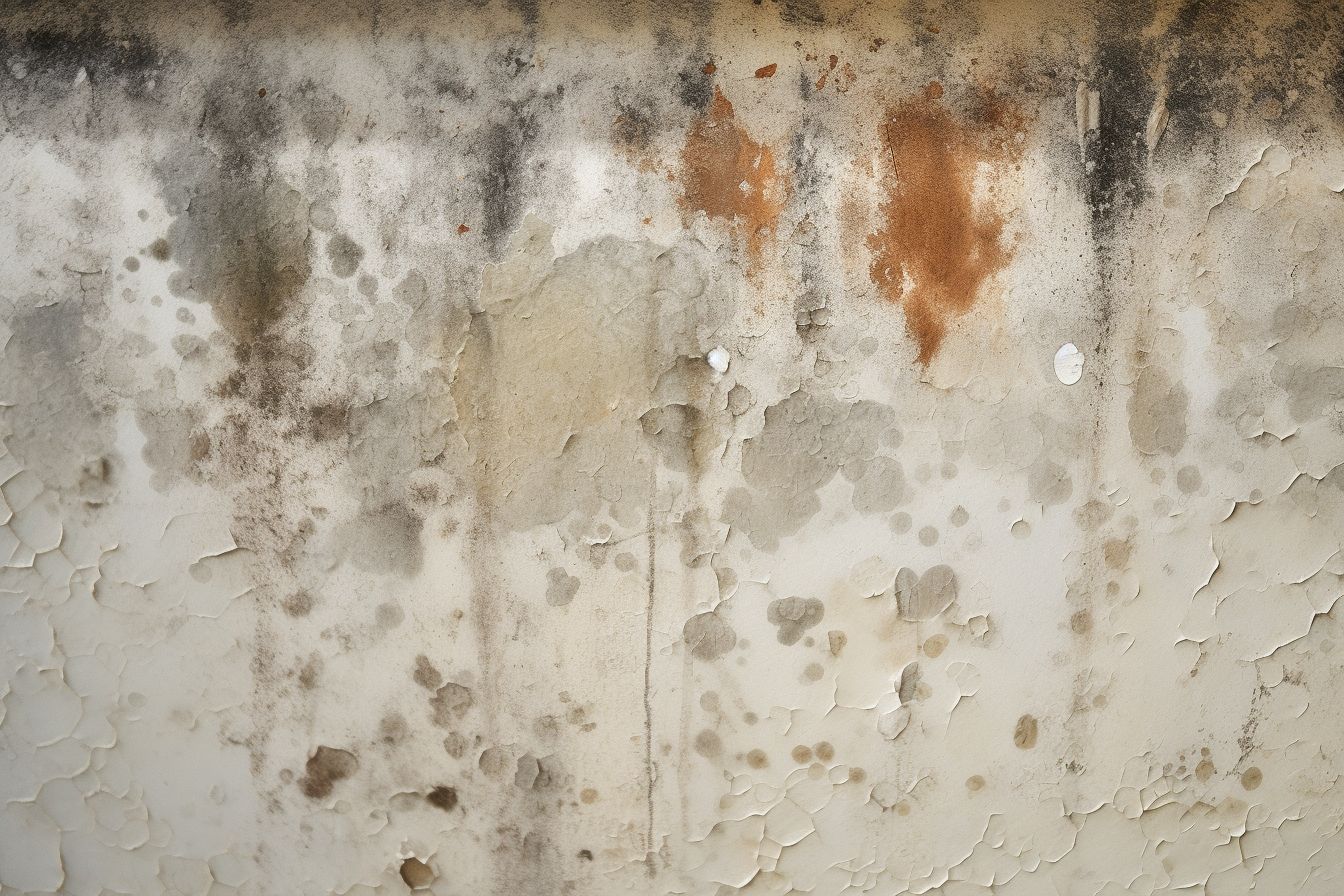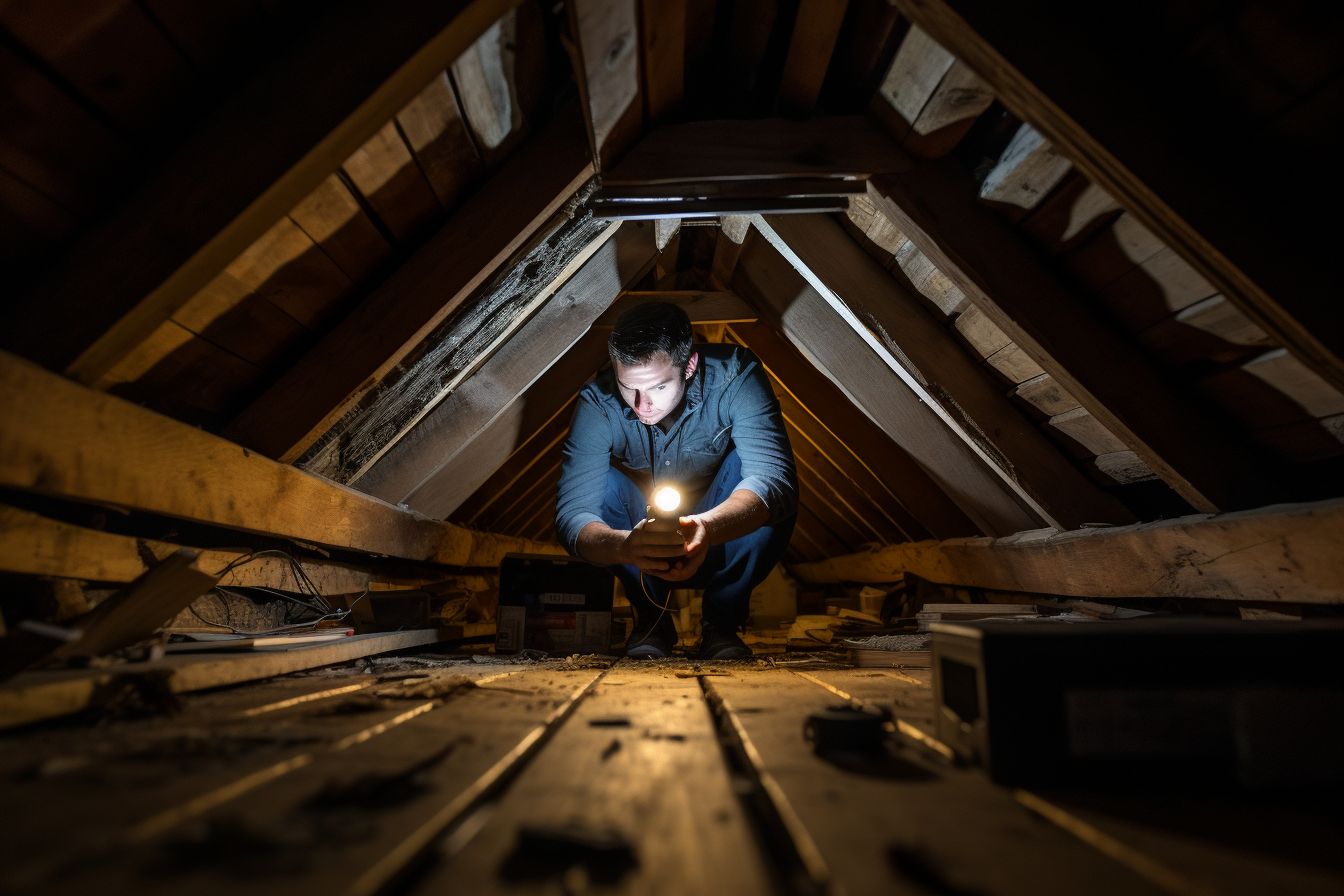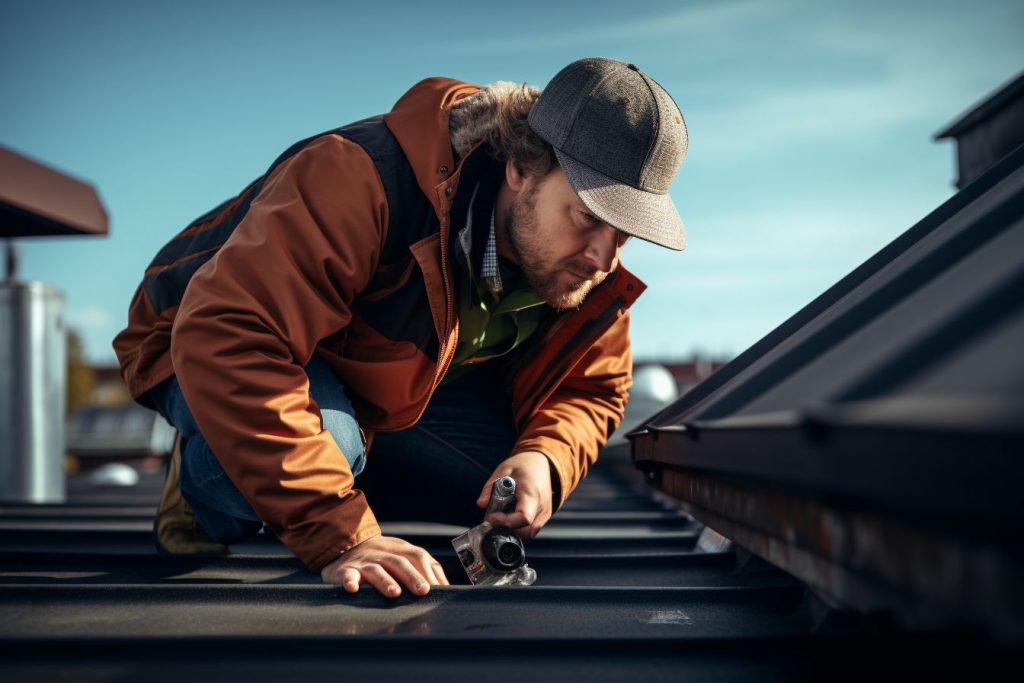Are you grappling with the constant annoyance of a roof leak but unsure where it’s coming from? It’s common knowledge that undetected roof leaks can lead to severe water damage over time.
This handy guide aims to equip you with the know-how for efficiently tracking these elusive leaks, saving your home from potential disaster. Take advantage of this; your dry, worry-free home is excellent!
Key Takeaways
- Look for stains on the ceiling and walls to identify potential roof leaks.
- Check for musty odours, as they may indicate hidden roof leaks.
- Inspect your attic regularly for signs of water damage to catch roof leaks early.
- Start at the area uphill from any stains when searching for the source of a leak.
- Use a hose to simulate rain and track the exact spot where water enters your home.
- Consider calling a professional roofer for complex or hard-to-find leaks.
- Take immediate action once you’ve located a leak to prevent further damage.
Signs and Initial Steps

Look for stains on the ceiling and walls, check for musty odours, and inspect the attic for signs of water damage.
Please be sure to look for stains on the ceiling and walls.
Dark circles or patches on your walls and ceiling often signal a roof leak. Water slipping through cracks in your roof leaves trace markings as it travels down into the interior of your home.
These stains typically have an outer brown ring with a yellowish centre, revealing the water’s path. The discolouration further proves leaking issues inside ceilings and behind drywall panels.
Over time, these stains may darken or grow larger; this progression indicates continuous leaks, causing worsening water damage inside your house. Track them from their origin point on the ceiling to discover the potential entry point of the water on your rooftop – this might be discoloured felt paper or rotten wood directing you uphill from stains for effective roof leak detection.
Check for musty odours.
Musty odours often indicate a hidden roof leak. This unpleasant smell comes from dampness, mould growth or mildew in your building. Water has a knack for travelling before it drips down visibly, sometimes causing mould and foul smells to appear away from the actual source of the roof leak.
To locate potential leaks, follow the scent of mustiness. The scent may be more assertive in certain areas. If you smell this odour persistently, it’s crucial to address it immediately, as prolonged moisture can lead to further damage, such as fungal growth or extensive water leakage.
Please take a look at the attic for signs of water damage.
Venturing into your attic can be crucial to uncover hidden water damage. Look for signs of roof leaks, such as water stains or mould growth on the walls and ceiling. These clues can point directly to troublesome issues in your roofing system.
An unnoticed leak could lead to more extensive, expensive repairs if not checked regularly or immediately after severe weather conditions like heavy rain or storm. By conducting frequent attic inspections, homeowners can prevent significant problems from arising and guarantee prompt repair action when required.
Locating the Roof Leak
Start at the area uphill from the stains and use a hose to simulate rain, tracking the source of the leak.
You can start at the area uphill from the stains.
To locate a roof leak, please look over the area uphill from any stains you find on your ceiling or walls. Water tends to flow downhill, so the leak source is likely higher on the roof.
By starting in this area, you can narrow your search and focus on finding the exact spot where water enters your home. This method will help you save time and effort as you track down and address the issue causing those unsightly stains.
Remember to be thorough in your inspection to prevent further damage to your roof and interior space.
Use a hose to simulate rain and track the source of the leak
Simulating rain with a hose can be an effective method to locate a roof leak. You can start by running the hose over the roof, focusing on the area uphill from any stains or water damage inside your home.
Please observe closely for any drips or signs of water entry points. I recommend having someone inside the house to check for leaks as you spray the roof. This technique is instrumental in identifying common problem areas such as vents, chimneys, skylights, and flashing.
By replicating rainfall using a garden hose, you can pinpoint exactly where the leak is coming from and take appropriate steps to fix it before further damage occurs.
Could you consider calling a professional for complex leaks?
For complex leaks, it is advisable to call a professional roofer. These complicated roof leaks can be challenging to locate and require expert knowledge and tools for detection. Professional roof repair experts have experience identifying hidden leaks and employing effective techniques for locating them.
By relying on their expertise, you can ensure prompt roof leak repair and prevent further damage to your home. Additionally, professionals can offer temporary fixes to address the issue until more extensive repairs can be made.
Remember that addressing complex leaks promptly is essential to protect your home from potential water damage.
Homeowner’s Guide to Handling Roof Leaks

Taking immediate action is essential to handle roof leaks as a homeowner effectively. Once you’ve found the leak (as discussed in the previous section), you can begin taking steps to address the issue.
If possible, contain the water by using buckets or other materials to catch any dripping water. This will help prevent further damage and protect your home from water-related problems.
Next, making temporary repairs is essential if it works for you and within your skill level. Small holes or damaged shingles can often be fixed with essential tools and materials from your local hardware store.
However, for more extensive repairs or unsure how to proceed, it’s best to consult a professional roofer. They have the expertise and knowledge to assess and repair roof leaks properly.
Remember that fixing the source of the leak should be prioritised over cosmetic repairs. By addressing the cause of the problem, you’ll minimise future damage and save yourself from potential headaches down the road.
Also, seeking help from a roofing contractor is crucial when dealing with complex leaks or emergencies that require immediate attention.
Handling roof leaks can be overwhelming as a homeowner, but following these guidelines will ensure that you take swift action while minimising further damage to your home.
Making Repairs
Repair small holes or damaged shingles promptly to prevent further water damage. Consult with a professional roofer for more extensive repairs, ensuring the source of the leak is fixed to prevent future leaks and damage.
Fix small holes or damaged shingles
Repairing small holes or damaged shingles is crucial in fixing roof leaks. These issues can often be the source of water penetration and should be addressed promptly to prevent further damage.
Flashing can be used instead of caulk to fix small holes for a more durable and long-lasting solution. Roofing cement can also be applied to repair any gaps or openings that may lead to leaks.
Temporary patches can be made using screws and a tarp until more permanent repairs are possible. Remember, even small roof leaks can cause significant damage, so addressing them quickly and effectively is essential.
Consulting with a professional roofer is advisable if you need clarification on the severity of the damage or if you have extensive repairs that need to be done. They have the expertise and tools necessary to handle complex leak issues efficiently.
Consult with a professional roofer for more extensive repairs
Regarding more extensive repairs for a roof leak, it’s best to have a professional roofer. They have the expertise and experience to handle complex leaks and provide effective solutions.
Expert roofers can repair the damaged area and assess other areas of the roof that may require repair or reconstruction. This ensures that all potential issues are addressed, preventing further damage.
So, if your roof leak is significant or beyond your capabilities, please don’t hesitate to contact a roofing professional to help resolve the problem effectively and efficiently.
Prioritise fixing the source of the leak to prevent further damage
I think fixing the source of a roof leak is essential to prevent any additional damage from occurring. Water can seep into the structure of your home, causing structural issues and encouraging the growth of mould and mildew.
By addressing the root cause of the leak promptly, you can avoid more extensive repairs and potential health hazards. It is essential to quickly reduce further water damage within your home or attic space.
Conclusion

Locating a roof leak may seem daunting, but by following the proper steps, you can identify and address the issue effectively. Please remember to check your attic for signs of water damage and start at the uphill area from any stains on your ceilings or walls.
You can also simulate rain using a hose to track down the source of the leak. And if all else fails, feel free to call in a professional for more complex leaks. With these tips in mind, you can tackle roof leaks confidently.
FAQs
1. How can I locate a roof leak?
You can locate a roof leak by inspecting your attic for water stains or mould growth, checking the roof for damaged or missing shingles, and using a hose to simulate rainfall and trace the source of the leak.
2. Can I fix a roof leak myself?
Fixing a small roof leak with basic DIY skills is possible, but hiring a professional roofer for more significant leaks or being unsure about the repair process is recommended.
3. What should I do if I find a roof leak?
If you find a roof leak, it’s essential to act promptly by placing buckets or containers to catch dripping water, securing any valuables or furniture that could be affected by water damage, and contacting a roofing professional for an assessment and repairs.
4. How much does it cost to repair a roof leak?
The cost of repairing a roof leak depends on various factors, such as the extent of the damage, type of roofing material, and accessibility of the area. It’s best to get multiple quotes from reputable roofing contractors for an accurate estimate.
5. How long does it take to fix a roof leak?
The time needed to fix a roof leak can vary depending on factors like the complexity of the repair and weather conditions. Small leaks may be resolved within hours, while extensive repairs could take several days or more.

